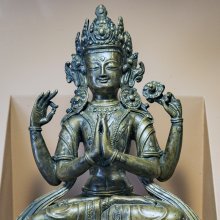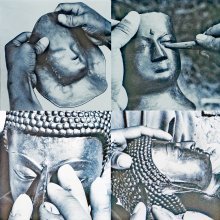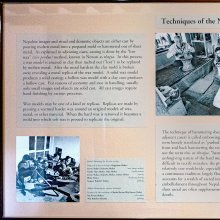Pressing: 2 definitions
Introduction:
Pressing means something in Hinduism, Sanskrit. If you want to know the exact meaning, history, etymology or English translation of this term then check out the descriptions on this page. Add your comment or reference to a book if you want to contribute to this summary article.
Images (photo gallery)
In Hinduism
Purana and Itihasa (epic history)
Source: Shodhganga: Elements of Art and Architecture in the Trtiyakhanda of the VisnudharmottarapuranaPressing the hair was traditionally practiced by professional barbers, as part of the “sixty four kinds of Art”, according to the Kamasutra of Vatsyayana.—Cf the Sanskrit “utsādane saṃvāhane keśamardane ca kauśalam” which refers to “proficiency in pressing, shampooing and dressing hair.”.—Indian tradition, basically includes sixty four Art forms are acknowledged. The history of Indian Art covers approximately five thousand years which presents a rich and almost continuous record. The references of sixty four kinds of Kala (कला, kalā) are found in the Bhagavatapurana, Shaiva-Tantras, Kamasutra of Vatsyayana etc.

The Purana (पुराण, purāṇas) refers to Sanskrit literature preserving ancient India’s vast cultural history, including historical legends, religious ceremonies, various arts and sciences. The eighteen mahapuranas total over 400,000 shlokas (metrical couplets) and date to at least several centuries BCE.
Natyashastra (theatrics and dramaturgy)
Source: Shodhganga: Elements of Art and Architecture in the Trtiyakhanda of the Visnudharmottarapurana (natya)1) The Pressing (of breast) is associated with the Pārśvakṛta variety of Sandaṃśahasta: one of the twenty-two Single-hand Gestures (in Indian Dramas) (known as asaṃyuktahastas), according to the Viṣṇudharmottarapurāṇa, an ancient Sanskrit text which (being encyclopedic in nature) deals with a variety of cultural topics such as arts, architecture, music, grammar and astronomy.—The word sandaṃśa means kaṅkamukha i.e., a pair of tong. Tong is a kind of tool which is used to hold something. [...] The Viṣṇudharmottarapurāṇa speaks of three kinds this form viz., agraja, mukhaja and pārśvakṛta and it gives detailed discussion of the usages of each one clearly. There are many uses of pārśvakṛta-sandaṃśa-hasta type viz., colouring of picture, pressing of breast, showing of head etc.
2) (The act of) Pressing is also associated with Niṣedhahasta: one of the thirteen Combined-hand Gestures (known as saṃyuktahastas).—The word niṣedha means prohibition. In the niṣedha posture mukula hand covers the kapittha hand and this posture is used in reducing, throwing and pressing.

Natyashastra (नाट्यशास्त्र, nāṭyaśāstra) refers to both the ancient Indian tradition (shastra) of performing arts, (natya—theatrics, drama, dance, music), as well as the name of a Sanskrit work dealing with these subjects. It also teaches the rules for composing Dramatic plays (nataka), construction and performance of Theater, and Poetic works (kavya).
See also (Relevant definitions)
Full-text (+441): Sambadhaka, Pidana, Sampidana, Mardana, Prapidana, Sammarda, Nigrabha, Utpidana, Sushvi, Amardin, Upatapa, Dharabigara, Sankashta, Prashlesha, Sadyahsutya, Paripidana, Jhubada, Vema, Motana, Utpida.
Relevant text
Search found 152 books and stories containing Pressing; (plurals include: Pressings). You can also click to the full overview containing English textual excerpts. Below are direct links for the most relevant articles:
Satapatha-brahmana (by Julius Eggeling)
Kāṇḍa IV, adhyāya 5, brāhmaṇa 9 < [Fourth Kāṇḍa]
Kāṇḍa XII, adhyāya 8, brāhmaṇa 2 < [Twelfth Kāṇḍa]
Kāṇḍa IV, adhyāya 1, brāhmaṇa 1 < [Fourth Kāṇḍa]
Bharadvaja-srauta-sutra (by C. G. Kashikar)
The Agnistoma Somayaga in the Shukla Yajurveda (by Madan Haloi)
Somasaṃsthā (3): Ukthya < [Chapter 3 - The Somayāga]
Part 5.4: Mid-day soma pressing (mādhyandina-savana) < [Chapter 4 - The Agniṣṭoma Ritual]
Soma in Vedic Mythology and Ritual (study) (by Anjana Chakraborty)
Chapter 3(i) - The rite of ‘pressing of Soma’ (Abhisavana)
Chapter 4 - The Synchronization of Rituals and Myths of Soma
The Sacrifices of Rajasuya, Vajapeya and Ashvamedha (study) (by Aparna Dhar)
Contents of the Brāhmaṇas of the Ṛgveda < [Chapter 1 - A brief outline of the Brāhmaṇa Literature]
Summary of the Soma Sacrifice / Agniṣṭoma < [Chapter 2 - Vedic Sacrifices described in the Śatapatha Brāhmaṇa]
Summary of the Sarvamedha sacrifice < [Chapter 2 - Vedic Sacrifices described in the Śatapatha Brāhmaṇa]
Shaiva Upanishads (A Critical Study) (by Arpita Chakraborty)
28b. Kālāgnirudra Upaniṣad on Three fires < [Chapter 2 - Greatness of Bhasma and Dhāraṇa]


